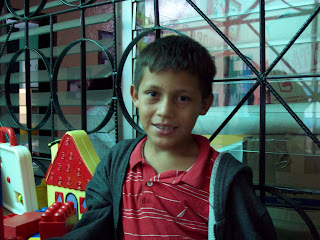We left Villa Gracia midmorning for our last mission-related stop: a visit to an organization that receives funding from our presbytery. The Proyecto altenative in downtown Tegucigalpa started as an outreach to marketplace kids* to help get them in school (education is not mandatory, and tuition and fees are high) and keep them off glue.* The Proyecto has expanded to include preschool education, secondary school scholarships, health care, and job-training for parents.
(R)The Proyecto Alternativo facility


The preschool classroom

A primary school client.
His mom brought him for a doctor's appointment.
 Proyecto staff members. The woman center is the Director. The young woman seated at right came to the program as a child and received assistance from primary school through high school, and became one of the first to receive a scholarship to a colegio (post-secondary, like a junior college here) . Upon graduation she returned to the Proyecto as a staff member.
Proyecto staff members. The woman center is the Director. The young woman seated at right came to the program as a child and received assistance from primary school through high school, and became one of the first to receive a scholarship to a colegio (post-secondary, like a junior college here) . Upon graduation she returned to the Proyecto as a staff member. * for more info on "marketplace children" and "street children" in Honduras, link here
http://www.tulane.edu/~rouxbee/kids02/hond1.html
for info on glue boys link here http://gvnet.com/streetchildren/Honduras.htm
In San Pedro Sula and Tegucigalpa we saw ragged boys sucking on plastic juice bottles containing a couple of inches of amber sludge. They hold the rim of the bottle in their teeth to keep the opening directly under the nose. They wander through traffic begging or selling trinkets. I know that crack and meth addiction are no less devastating here, but this sight tore at my heart. With such a visible token of destruction there is no avoiding the obvious. And these were all kids, all boys -- which leads one to equally grim realizations of where all the girls are.
Glue-sniffing is the drug scourge of Latin American cities. Glue is cheap and kills hunger, making it attractive to starving kids. The glue is so toxic, and these kids so depleted to begin with, that survival is a matter of weeks or months. Entire missions have developed to cope exclusively with reaching the glue boys.
Three times on this trip, Loren and I simultaneously hesitated in our incessant photo-snapping, and then lowered our cameras. Silent agreement that to take a photo was a further violation, an exploitation of this person's misery. The first and last instances were the glue boys. The other was a man passed out in the middle of the mountain road, a victim of market-day binge (market-day is payday). All three times we had that moment of clarity, the moment of decision not to be a tourist. Yet here I am describing the images I could not commit to film.
The whole week was, for me, a delicate balance of conscience: bearing witness to the work of the Co-op and the Proyecto weighed against the inherent voyeurism of mission-tripping. I can better understand my parents' unease in their mission years. They came to feel that they were being asked to inflict US culture on the community rather than address the needs that were mandated by their undertanding of Christianity --feed the hungry, clothe the needy, heal the sick, and teach the love of Christ.
Contrary to popular cynicism, most missionaries are well aware that they bring cultural baggage replete with self-righteous assumptions and prejudices. They are also well aware that they are blind to the specifics of this baggage. They are no more likely to behave like 19th century colonialists than anyone else visiting a poor society. No more likely, though perhaps equally likely.
But no one, no one ever became a missionary to get rich.














